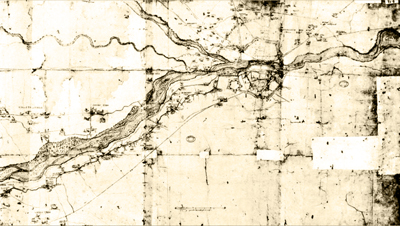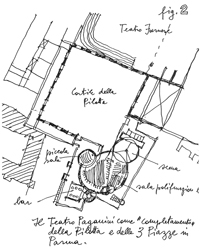You are in: Home page > Magazine Archive > Beyond the city
Over the last twenty years we have stepped beyond the conditions through which architecture and city could have continued to establish a meaningful reciprocity. The city has infiltrated the territorial space thereby losing many of its indications of form, structure, and functional and identifying role. As a result the subject, being a city, starts to be foregone. In this context, beyond the techno-political attempts of the smart city, the re-affirmation of the city must avail itself of a project approach that works on the body of the constructed city, on the form and structure of an urban density called upon to redefine the city’s community meaning.
Over the last twenty years, particularly in the Italian context but not only, we have stepped beyond the conditions through which architecture and city could have continued to establish a meaningful reciprocity. A beyond that impacts the spatial nature, the relational state, but also that image which can no longer semantically represent the collective presupposition of being a city. The surpassing of this limit and the statutes that have animated the continuous re-elaboration of the urban theme — unquestionably occasionally conflictual and ideological, from the experimentation of the Modern to its bogus inertias or the reactions of post-modernist historicism — has decreed the by this time generalized lack of reference models of settlement expressions. We find ourselves in a sort of relativistic space of added built objects in the absence of a logic of relations that are not exclusively opportunistic and self-referential.
Drawing inspiration from recent historical phenomenology, starting from the Nineties, through the subordinate and at times merely technical contribution of town planning, conditioned for example by the engineering of infrastructures as a primary prerogative of a not always well defined economic development, we witness the weakening of planning quality and the ensuing programmer trends in terms that are inversely proportional to a construction industry fed by land income and the real estate factor – in which the public administration itself participates through the mechanism of tax collection – thereby determining a scenario we might define as speculation on return, analogous to what happened in the historical contingency of the post war building boom between the ’50s and ’60s. The case of Rome yesterday and today ends up paradigmatic in this sense. With the aggravating difference that these phenomena were the object — as early as the mid-Sixties and even more so in the ensuing years — of critical assessment, of the rethinking of developmental models, and of the elaboration of alternative strategies in a position to interpret the qualitative tradition of Italian settlement contexts along with the landscape that characterizes them, in a perspective of transformation capable of further implementing their peculiarities and values. Something extraordinary and possibly unique at the European level in this sense is the theoretical and scientific production centred on the relationship between architecture and city provided by Italian architectural culture, universities, research centres, and individual contributions, albeit all substantially ignored. A dispersion of intellectual energies and unfulfilled projects despite the players involved in public and private urban transformation, occasioned staggering amounts of economic, spatial, and environmental resources in those years.
Nonetheless, in the face of this having gone beyond, the subsequent action of reflection and critical withdrawal of proposals within the physical and identifying body of the city meant a renewed commitment of the disciplines of city architecture, no less than a change in political and production trends that was able to acknowledge a rational vision designed for innovative models of collective interest.
Thus, in terms of priority, what we are now facing is a problem of a cultural dimension to be redefined, starting from the basic relationship between theory and practice, between science (architectural and urban in this case) and powers (political administrative and economic, those of “doing” to be clear), returning to question ourselves on what the city should be, and what kinds of collective behaviour currently claim to safeguard individual varieties.
In this cherished vogue, entering into the merit of certain general criteria, something fundamental is the distinction between polis and civitas underlined by Massimo Cacciari (La Città, 2004) to which corresponds, for the former, a unitary condition that is fundamentally tribal albeit rich in dialectics of political thinking, and for the latter the formalization on a juridical basis of the pact of citizenship between socially heterogeneous individuals as a presupposition of their political participation. In other words, the added evolutionary value of civitas with respect to polis seems to have been provided by the structure factor, under the profile of the institutional form and the sociality that understandably ensues, but also — and historical testimony demonstrates this — of the urban form and the settlement components that structure it. Certainly, the indispensable relationship between structure and urban phenomenology still appears undescribed in these general terms, however it is important to clinch the conceptual function at the moment when the project tackles the anti-city or, worse, its contradiction by evanescence, the non-city. Seeking thus to surmount the ideology of the fatalistic relativism of being which has all become – alas – territorial and devoid of city (which is above all something quite different from being “disurbanist”), perhaps in the driving force of presumptively poleogenetic infrastructures – there where sprawl and conurbation are traded for city – in accordance with a dispersive dynamic of metropolitan taste of a global kind, extirpated from places and memories, from which issues forth a mundane architectural expression that has difficulty competing with the seductiveness of the media image.
As a consequence, it is necessary to encourage an authentic urban project quality that can be initiated through a city subject that designs its own body (form) and its own role (function) with awareness of its own physiology (relationships), where the individualities are integrated in a unitary, structured, evolutionary procedure, only insofar as urban. And this urban sense of the project must not fall into the ambiguity of identifying design only in participation, which remains an important cognitive and empathetic process phase of the actual design, but cannot replace the responsibility of operative interpretation, that of a true techne, in this case of city architecture.
The same reclaimed notion of city that is promoted through the so-called “smart city” cannot be adopted in a decisive key given that it is all within a techno-political version of understanding settlement quality as a mere performance setting, for instance, in terms of energy, transport and communication, and environment. A set of factors, albeit of the maximum importance, which however patently do not suffice to make a city; that of architectural figures, urban scenarios, the symbolic and representative contribution, of relating within a space with a recognized value only as much as it conforms.
In this far from easy returning to the city from beyond the city, conscious of being in a new historical phase, the route needs to touch certain points as presuppositions of the project action including:
1) The city of future projects cannot continue to pursue the territory or pseudo-city of settlement dispersion, given that too often there are no longer the conditions to mend, sew back together, or reconnect as the city of the Eighties might still have permitted. The territory of sub-urban sprawl must self-heal, self-reconstruct, must find its own economy of role and sense of identity. If anything it is necessary to question the ever determinant relationship between city and territory as distinct subjects and only because of this able to establish meaningful relationships of exchange, bearing in mind the vocations of the regional space such as that which, through transport and communication systems, brings cities closer together thereby determining fresh polycentric networks that dispense with geographical vicinity.
2) The city needs to examine itself from a project perspective and nothing of its own body is exempt from critical interpretation: the earliest centre, the historical suburbs of the twentieth century, those of the fin de siècle and above all those realized more recently, as well as all that potential settlement area lying on the paper of countless plans still current but characterized by an anachronistic vision given that they were drawn up within quite different historical circumstances.
3) Diseconomy in the use of urban space anticipates that any developments of the city will be included inside its body. The practice of densification which, in the event that it fulfils the quantitative and from many points of view also morphological needs of the city, cannot however be imagined outside a logic of structuring the urban body. In which participates a conscious dialectic between fullness and emptiness, between functions, in particular public ones, and fruition needs, among figuratively meaningful elements in a hierarchical design within which to arrange centrality, aggregation spaces, and symbolic figures.
Never like today — after having gone beyond the space and sense of the city, in the relativism of settlement arbitrariness, dispersion of single entities, and loss of identifying imagery — can cities open themselves up to projects, newly accessible to further stages of a historical evolution that reaffirms them. A story which it is our duty to write and even more, design.
Bibliography
AA.VV., Per un’idea di città, Venezia 1984.
Canella, G., La diffusione del centro, in Zodiac 13, 1995.
Cacciari, M., La città, Rimini, 2004
Aymonino, C., Il significato delle città, Venezia 2000.
Quintelli, C., Comunità/architettura, in AA.VV., Comunità/architettura (a cura di E. Prandi), Parma 2010.
Quintelli, C., Progettare il costruito - Per un’architettura di interni (urbani) in AA.VV., European City Architecture a cura di L. Amistadi, E. Prandi, Parma 2011
Carlo Quintelli, Full Professor of Architectural and Urban Composition, he teaching at the Faculty of Architecture of Parma. Since 2012, he has been vice director of the DICATeA, Department of Civil Engineering, Environment, Territory and Architecture of the University of Parma.

















